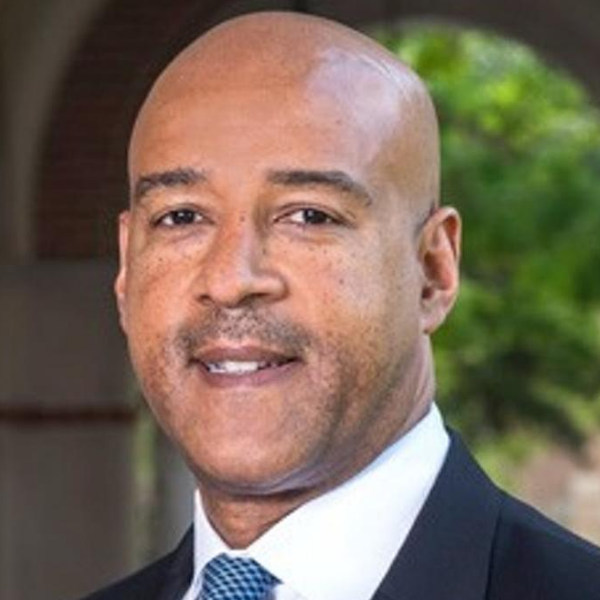TAMEST Member Profile: Reginald DesRoches, Ph.D. (NAE)

On July 1, 2020, TAMEST Member Reginald DesRoches, Ph.D. (NAE) pivoted from a long career in infrastructure system design and resiliency to take on the role of Howard Hughes Provost at Rice University. In this role, he works closely with his university’s president to advance the teaching, research and service mission at Rice.
Prior to his transition to Provost, Dr. DesRoches was the William and Stephanie Sick Dean of Engineering for Rice’s George R. Brown School of Engineering, known for his work in infrastructure design. As a fellow of the American Society of Civil Engineers and the society’s Structural Engineering Institute, Dr. DesRoches served as the key technical leader in the United States’ response to the 2010 earthquake in Haiti, taking a team of 28 engineers, architects, city planners, and social scientists to study the impact of the earthquake.
He has also participated in numerous congressional briefings to underscore the critical role that university research must play in addressing the country’s declining infrastructure and improving the nation’s resilience to natural hazards. Earlier this year, Dr. DesRoches was inducted into the National Academy of Engineering for research and design of resilient infrastructure systems to mitigate damage from natural disasters and other extreme conditions, making him one of TAMEST’s newest members.
Dr. DesRoches says it wasn’t easy assuming a new leadership role during the pandemic, but that he and other academic leaders across the state are doing everything they can to continue to set academic priorities in Texas while keeping the health and safety of their communities’ top of mind. On August 26, Dr. DesRoches will share more of his experience at a TAMEST conversation on the Impacts of COVID-19 on Higher Education in Texas as part of our Forward Texas Digital Series.
TAMEST connected with Dr. DesRoches to learn about his work and how he is navigating the barriers that come with educating students and fostering research in the middle of a pandemic.
Tell us a little about yourself.
I am currently the Provost at Rice University. In that role, I serve as the chief academic officer for the university. The Provost leads academic programs and initiatives across the university’s seven schools, which serve over 7,000 students and numerous centers and institutes.
Prior to this position, I served as Dean of the School of Engineering at Rice. I am a structural earthquake engineer and spent my first 19 years as a member of the faculty at The Georgia Institute of Technology (Georgia Tech). My research is in the design of resilient infrastructure systems under extreme loads and the application of smart materials.
I am originally from Haiti and grew up in New York City.
What made you get into the field of structural engineering and infrastructure resiliency?
I was a student at the University of California, Berkeley, in 1989 when the Loma Prieta earthquake struck the region. That really got me interested in studying earthquake engineering. I was a mechanical engineering major at the time.
I completed my Bachelor of Science in Mechanical Engineering but switched to Civil Engineering for my doctoral degree. I have been studying earthquakes ever since that time.
What do you wish more people knew about your work?
Very few people know what a Provost is and what they do. It is a complex job and touches nearly every aspect of a university. The work involves interaction with faculty, students, staff, parents, and local industry. It requires balancing competing interests and constantly making tough decisions.
It is also a position that can have a huge impact on a university, particularly as it pertains to setting academic priorities and setting a strategic vision around recruitment of faculty.
How is COVID-19 currently impacting your work and how are you handling it?
COVID-19 is having a huge impact on higher education and certainly a big impact on how I spend my day. The majority of my time is spent on items related to COVID-19. I am focused on both the short-term challenges, and how we can prepare for the long-term challenges that COVID will have on higher education.
In the short term, we are working on a strategy to re-open campus in mid-August and are planning to adopt a system of measures that are designed to make our campus as safe as possible from COVID-19 while continuing to fulfill our mission as a premier institution of higher education and research. This is a huge challenge for all institutions of higher learning.
What long-term impacts do you see from COVID-19 in higher education?
I think there are several near-term and long-term impacts from COVID-19. In the near term, you will see less focus on international exchange programs, and fewer international students will come study in the United States.
In the long term, I think we will see an increasing role for online education and blended learning (mix of online and in-person). The technology has improved and students appreciate the flexibility afforded by some content being online.
What advice would you give to people starting out in STEM careers?
I think STEM careers are the best. If you think about the most pressing challenges in the world, they will be solved by people in STEM fields.
From clean energy and climate change to the curing of challenging diseases – all of these will require expertise from the STEM fields. I also believe that STEM degrees are great for a range of jobs, from medicine to law. STEM degrees teach you how to solve complex problems.
What value do you think TAMEST brings to Texas?
TAMEST has the ability to convene the top experts to address some of the most challenging problems, not just for Texas, but for the world. It is a great asset to Texas.
I have not been to a TAMEST meeting yet, as I was just elected to the National Academy of Engineering this year, but I hear they are very interesting and bring together an impressive group of people.

